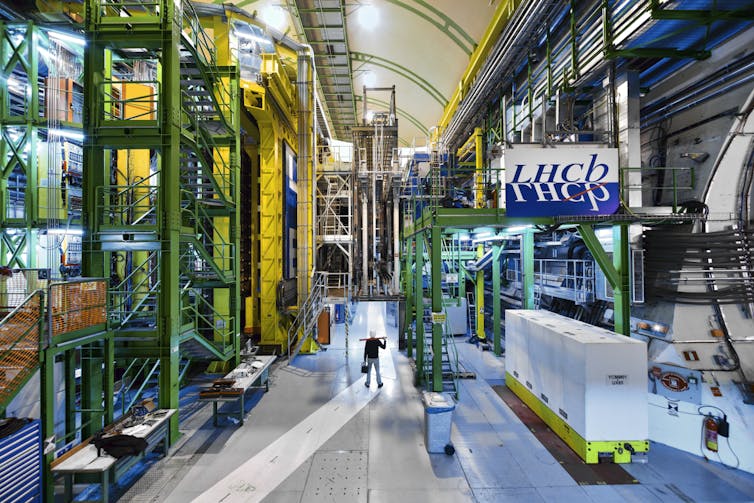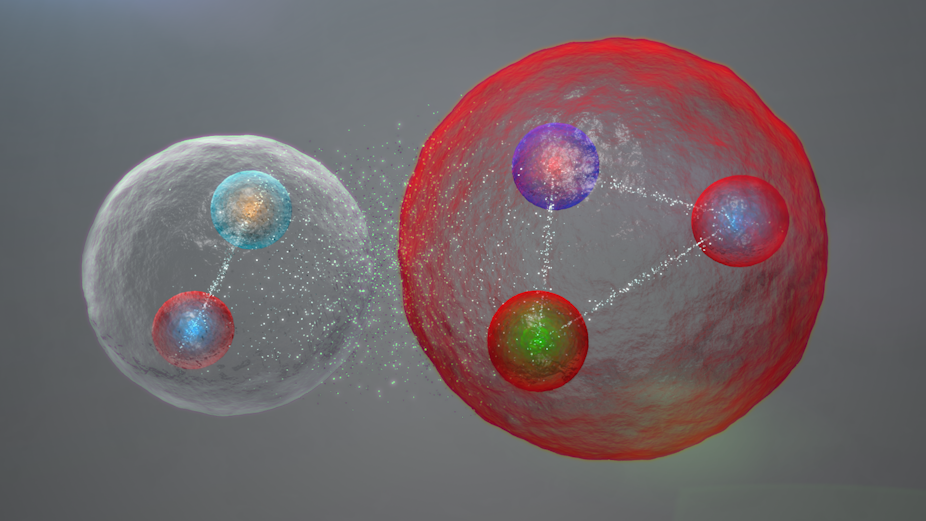you see around you is made up of elementary particles called quarks and leptons, which can combine to form bigger particles such as protons or atoms. But that doesn’t make them boring – these subatomic particles can also combine in exotic ways we’ve never spotted. Now CERN’s LHCb collaboration has announced the discovery of a clutch of new particles dubbed “pentaquarks”. The results can help unveil many mysteries of the theory of quarks, a key part of the standard model of particle physics.
Quarks were first proposed to explain the untidy slew of new particles discovered in cosmic ray and collider experiments in the mid 20th century. This growing “zoo” of apparently fundamental particles caused consternation among physicists, who have a natural bias towards simplicity and order – and hate having to remember more than a few basic principles. The famous Italian physicist Enrico Fermi captured the mood of his colleagues when he said “Young man, if I could remember the names of all these particles, I would have been a botanist”.
Fortunately, in the 1960s, the American physicist Murray Gell-Mannnoticed patterns in the particle zoo, similar to those spotted by Dimitri Mendeleev when he drew up the periodic table of the chemical elements. Just as the periodic table implied the existence of things smaller than atoms, Gell-Mann’s theory suggested the existence of a new class of fundamental particles. Particle physicists were eventually able to explain the hundreds of particles in the zoo as being made up of a much smaller number of truly fundamental particles called quarks.
Mystery hadrons
There are six types of quarks in the standard model – down, up, strange, charm, bottom and top. These also have “antimatter” companions – it is believed that every particle has an antimatter version that is virtually identical to itself, but with the opposite charge. Quarks and antiquarks get bound together to make particles known as hadrons.
According to Gell-Mann’s model, there are two broad classes of hadrons. One is particles made of three quarks called baryons (which include the protons and neutrons that make up the atomic nucleus) and the other particles made of a quark and an antiquark known as mesons.
Until recently, baryons and mesons were the only types of hadrons that had been seen in experiments. However, back in the 1960s, Gell-Mann also raised the possibility of more exotic combinations of quarks, such as tetraquarks (two quarks and two antiquarks) and pentaquarks (four quarks and one antiquark).
In 2014, LHCb, which runs one of the four giant experiments at CERN’s Large Hadron Collider, published a result showing that the snappily named Z(4430)+ particle was a tetraquark. This started a flurry of interest in new exotic hadrons. Then, in 2015, LHCb announced the discovery of the first ever pentaquark, adding a brand new class of particle to the hadron family.
The results presented by LHCb today expand upon that first pentaquark discovery by finding additional such particles. This was possible thanks to a big chunk of new data recorded during the second run of the Large Hadron Collider. Liming Zhang, an associate professor at Tsinghua University in Beijing and one of the physicists who made the measurement, said that “we now have ten times more data than in 2015, which allows us to see more exciting and finer structures than we could before.” When Liming and his colleagues examined the original pentaquark discovered in 2015, they were surprised to find that it had split in two. The original pentaquark was actually two separate pentaquark particles that had such similar masses that they originally looked like a single particle.

As if two pentaquarks for the price of one wasn’t exciting enough, LHCb also found a third pentaquark with a slightly smaller mass than the other two. All three pentaquarks are made of one down quark, two up quarks, a charm quark and a charm antiquark.
The big question now is: what is the precise internal structure of these pentaquarks? One option is that they are truly made of five quarks, with all of them mixed together evenly within a single hadron. Another possibility is that the pentaquarks are really a baryon and a meson stuck together to form a loosely bound molecule, similar to the way that protons and neutrons bind together inside the atomic nucleus.
Tomasz Skwarnicki, a professor of physics at Syracuse University in New York who also worked on the measurement, told me that the new companion state “is at a mass which offers hints about internal structure of pentaquarks”. The most likely option is that these pentaquarks are baryon-meson molecules, he added. To be absolutely sure, physicists will need more experimental data, as well as further studies from theorists, meaning that the story of these pentaquarks is far from over.
These results complete a week of exciting new announcements from LHCb, which included the discovery of a new kind of matter-antimatter asymmetry. The LHC has yet to discover any particles beyond the standard model that could help to explain mysteries like dark matter, an invisible but unknown substance that makes up the majority of matter in the universe.
But these exciting measurements show that there is still lots to learn about the particles and forces of the standard model. It may be that our best chance of finding answers to the big questions facing fundamental physics in the 21st century lies in more detailed studies of the particles we already know about rather than discovering new ones. Either way, we still have a great deal to discover.
 Discovery or Joke?
Discovery or Joke?

